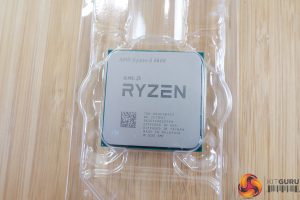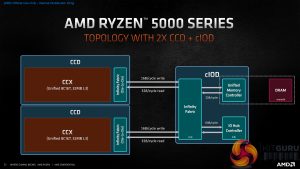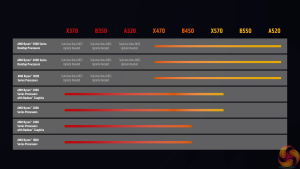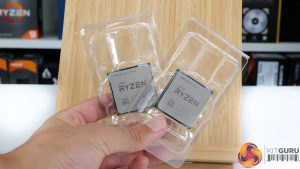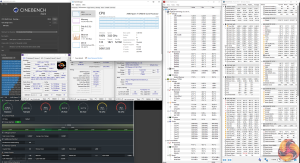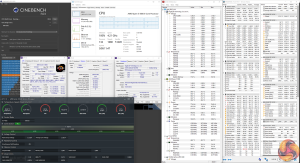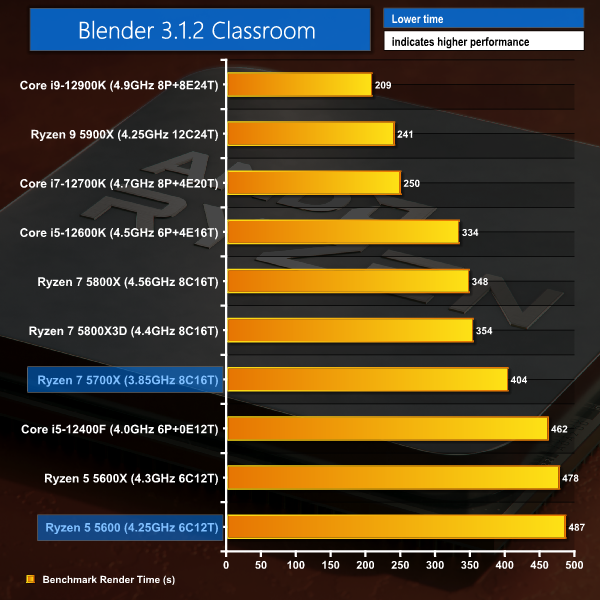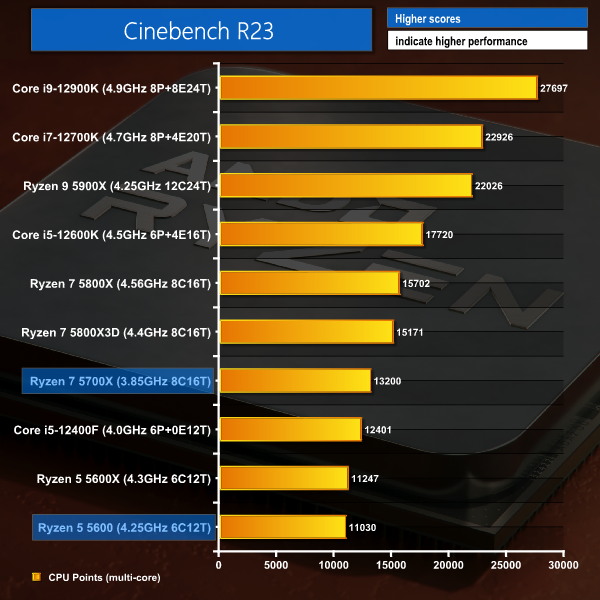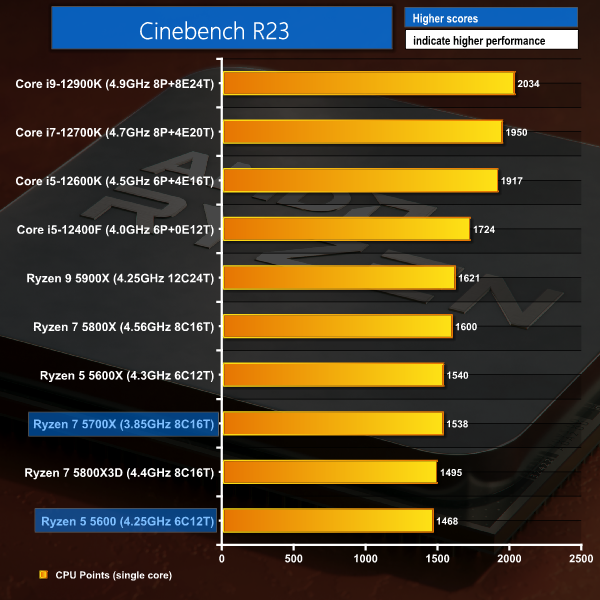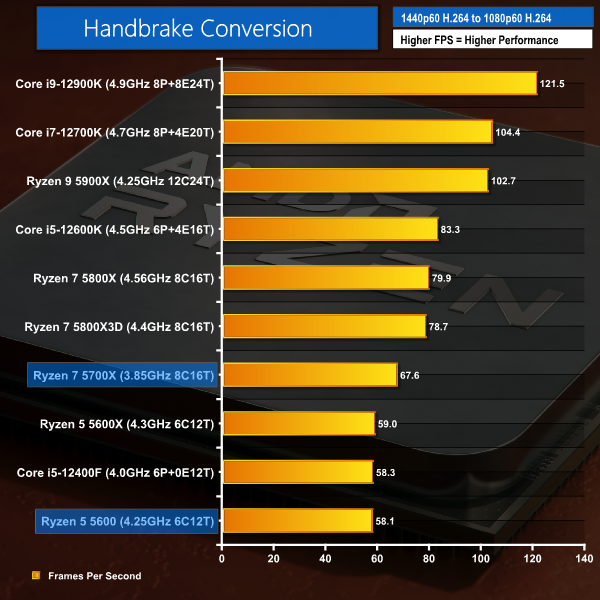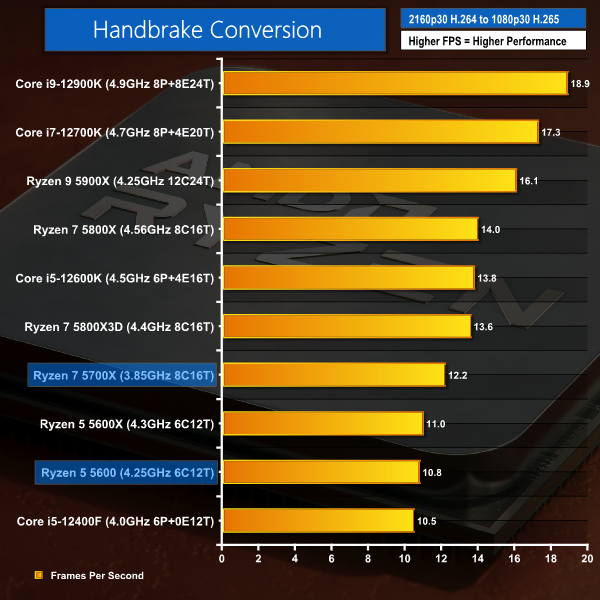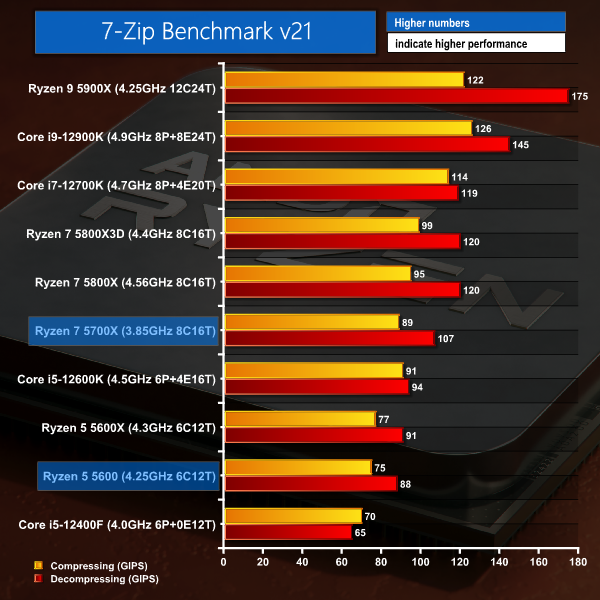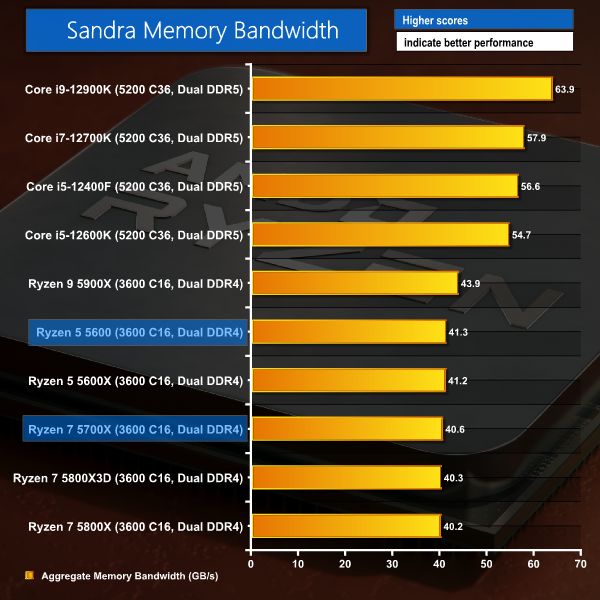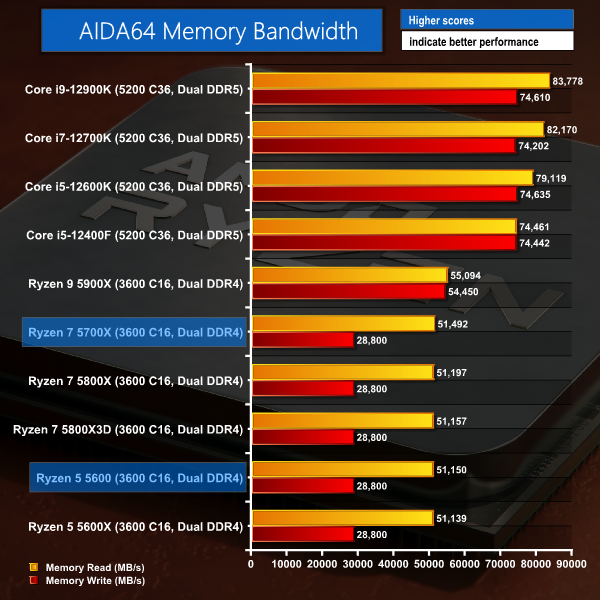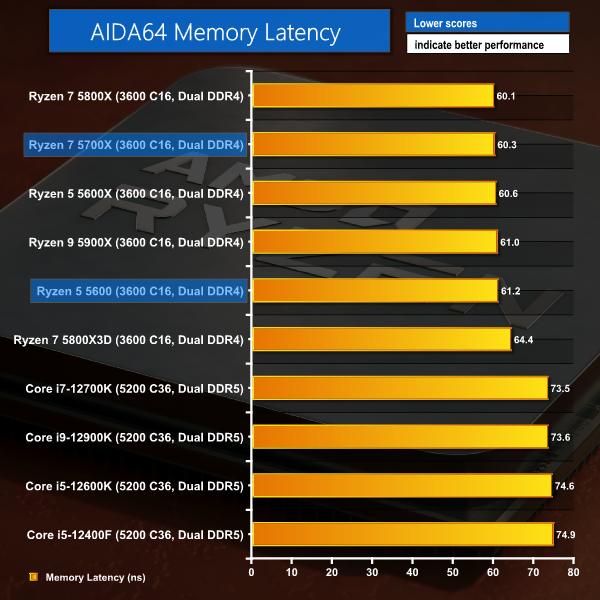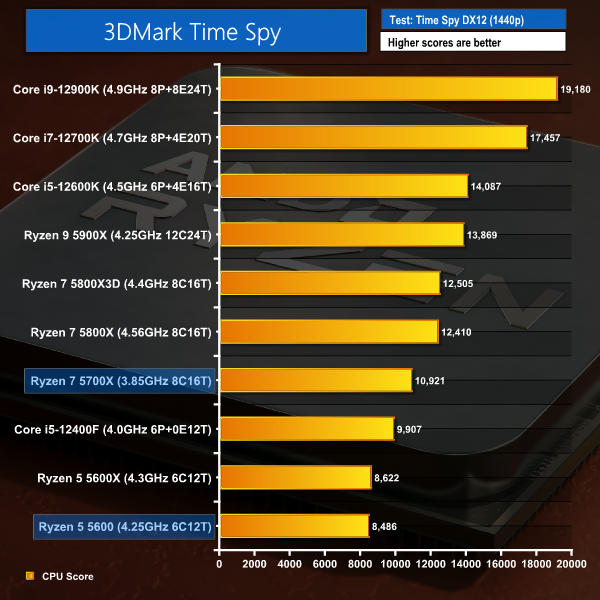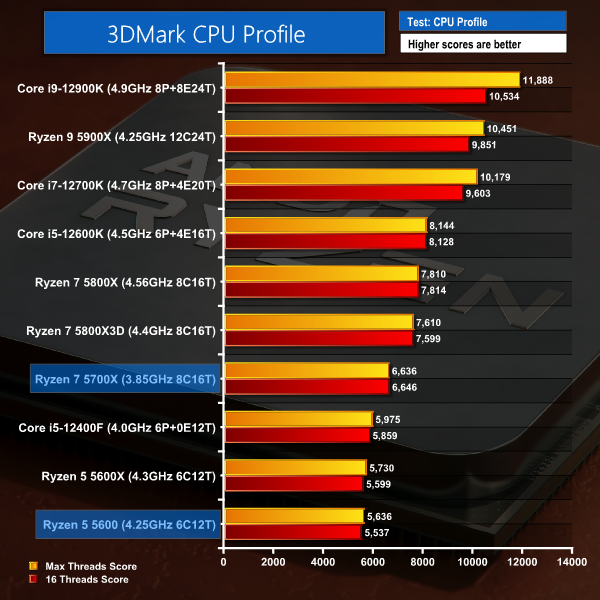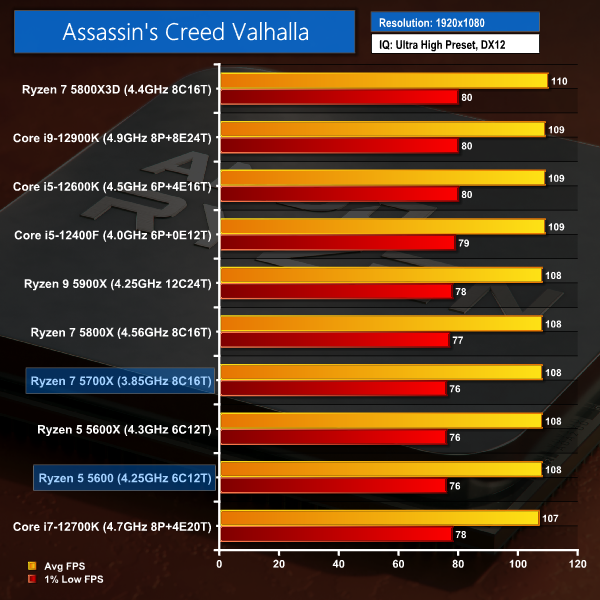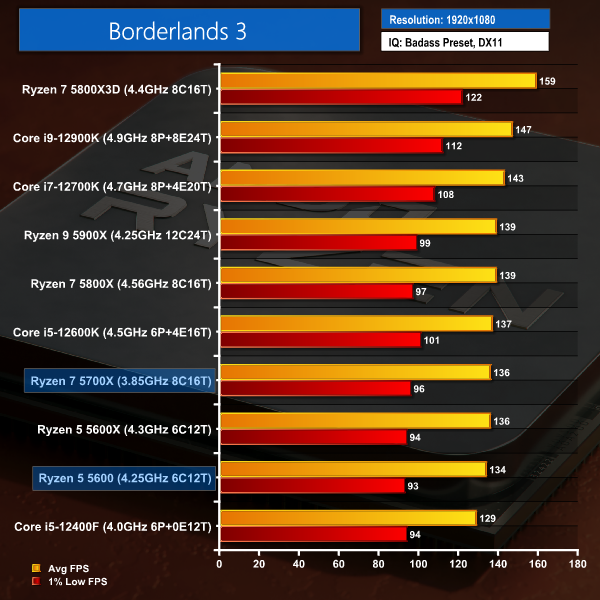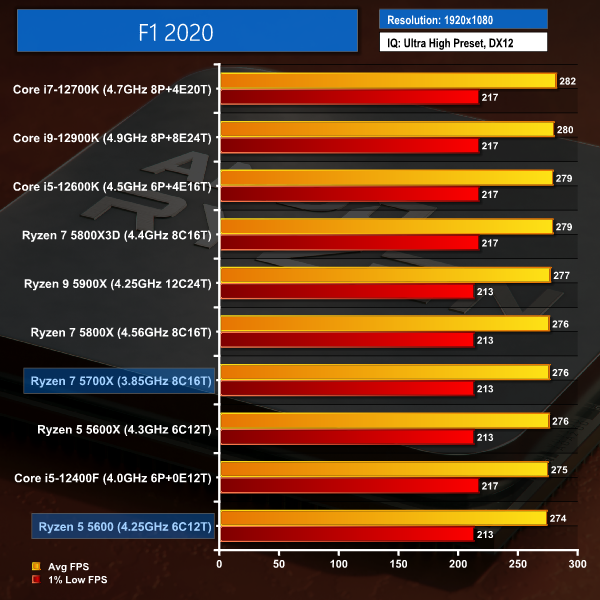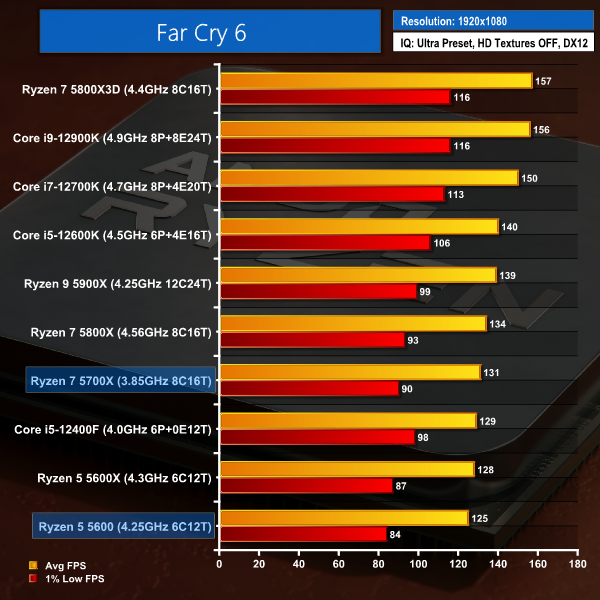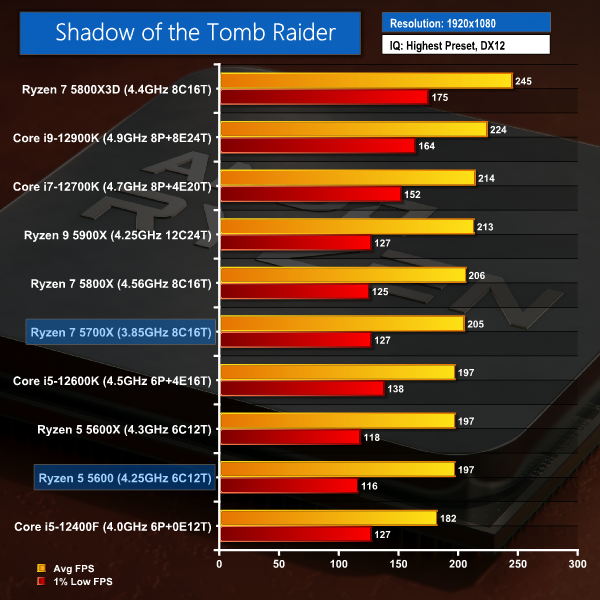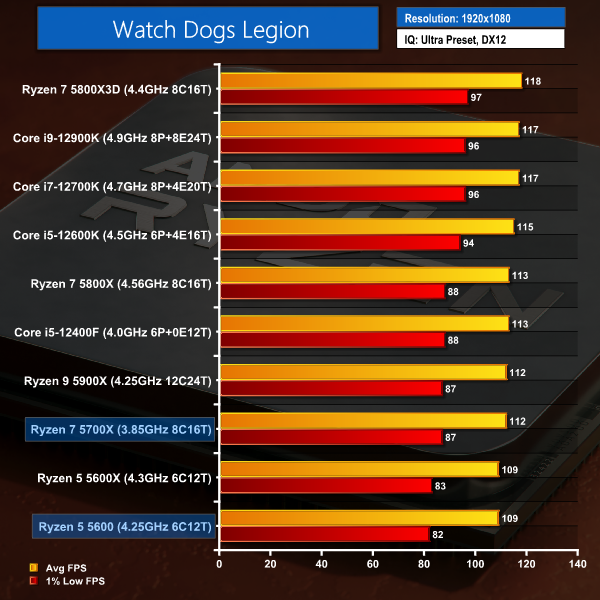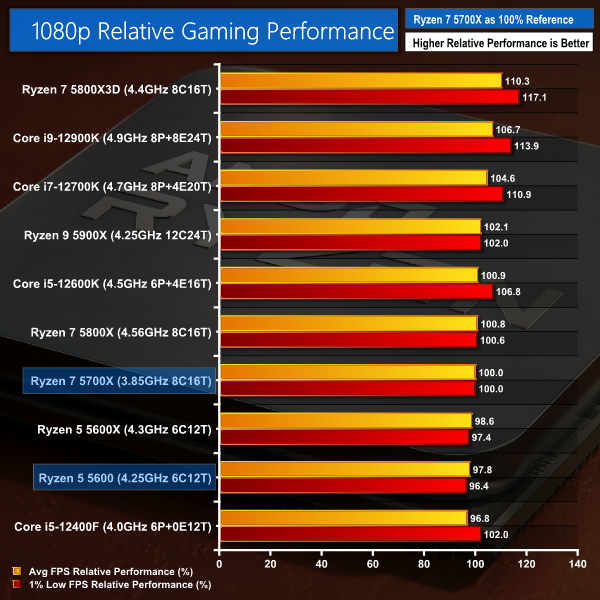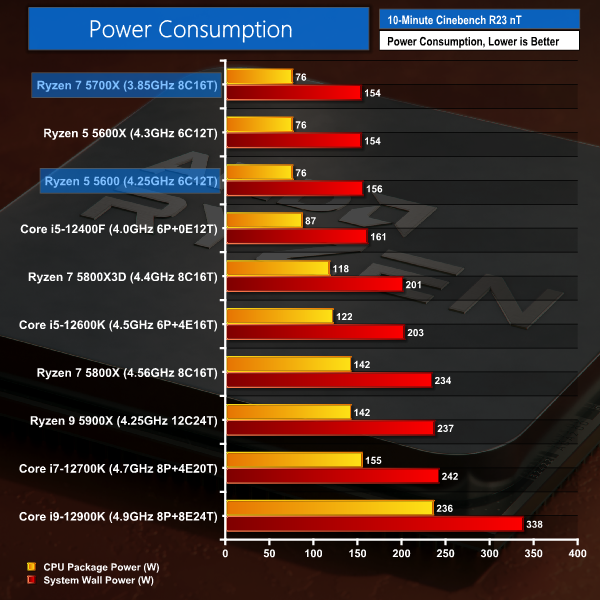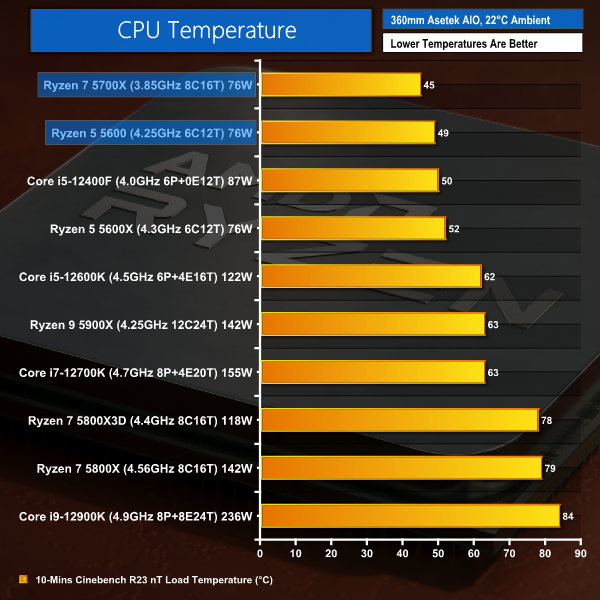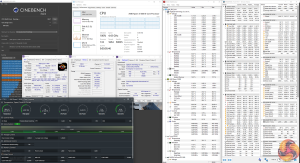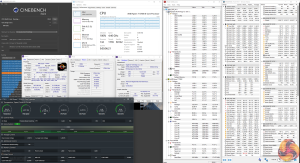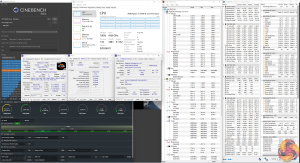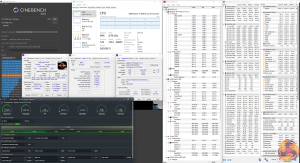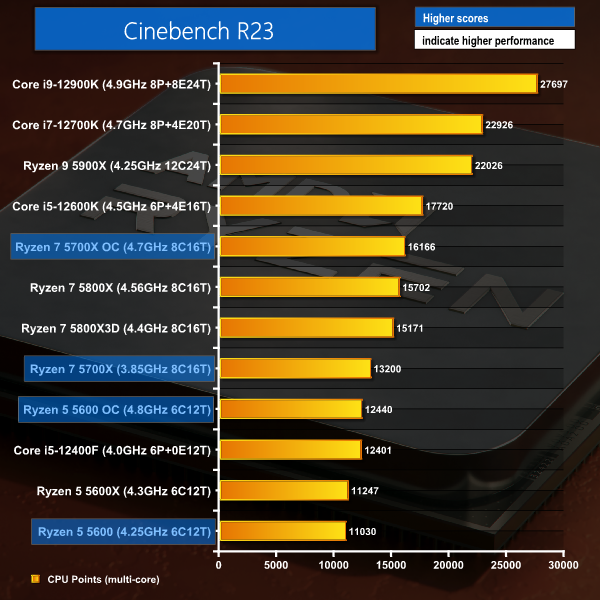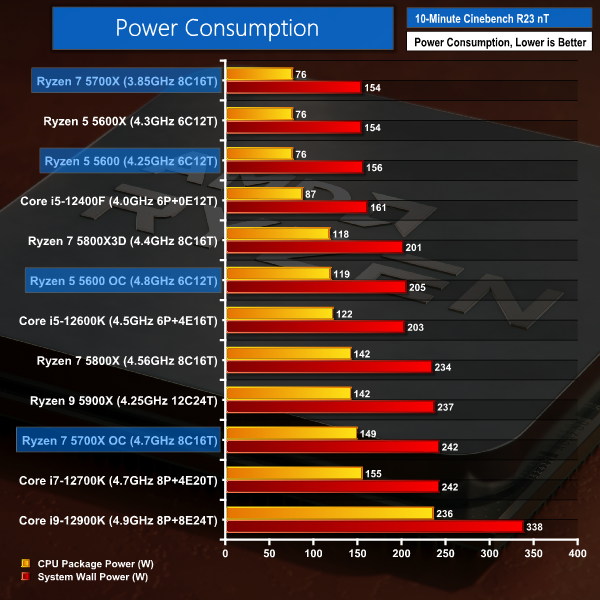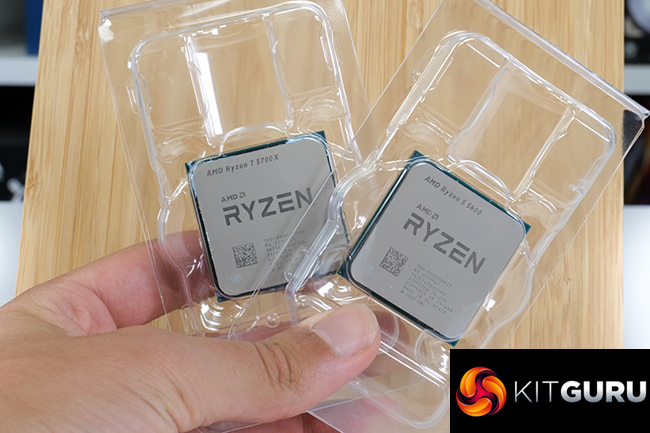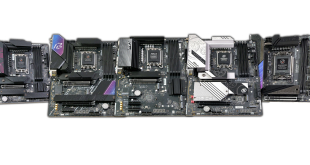AMD’s Ryzen 5 5600X and Ryzen 7 5800X have been the company’s go-to six-core and eight-core models since their introduction in late 2020. Healthy performance offerings coupled with numerous price drops made them firm fan favourites for a long period of time. But in late 2021, Intel struck back with formidable competitors in the 12th Gen Alder Lake line-up – most notably the sub-£300 Core i5-12600K.
AMD knew that a retaliation blow was a necessity, particularly given the hefty price drops already applied to Ryzen 5 5600X and Ryzen 7 5800X SKUs. And this is where the new, lower-cost Ryzen 7 5700X and Ryzen 5 5600 come into the picture.
Timestamps
00:00 Start
01:00 AMD 5700X / 5600 details
04:04 Comparison procedures
05:49 Clock speeds
06:47 Test results
09:07 Gaming results
12:05 Power Consumption
12:57 CPU temperatures
13:37 Precision boost Overdrive tuning
14:15 Manual overclocking
15:15 Overclocked results
16:07 Luke's closing thoughts
Ryzen 7 5700X has 8 cores and 16 threads with 36MB of total cache – 32MB of which is L3. Base clock is listed at 3.4GHz – 400MHz slower than the 5800X – and maximum boost clock is 4.6GHz – 100MHz slower than the 5800X.
Notably, the 5700X’s TDP is 65W rather than the 105W of the 5800X. This will likely have a considerable influence on the actual Precision Boost 2 operating speeds of both chips. Particularly as neither come with a boxed cooler and so a good AIO or air heatsink is anticipated for usage.
In the UK, the Ryzen 7 5800X is around £290-310, but mainly around £310. Whereas the new 5700X is around £270. Intel’s notable competitor is the £270 Core i5-12600K that features six Performance cores and 4 Efficient cores for sixteen total threads.
Ryzen 5 5600 has 6 cores and 12 threads with 32MB of L3 cache and 3MB of L2 cache. Base clock is listed at 3.5GHz – 200MHz slower than the 5600X – and maximum boost clock is noted as 4.4GHz – 200MHz slower than the 5600X, though this remains to be seen in actual operation.
TDP for both Ryzen 5 chips is 65W and they both ship with the same AMD Wraith Stealth CPU cooler. So, I am anticipating very comparable real-world operating clocks from both of the Ryzen 5 parts. And if that is the case, it may make the newer – cheaper – Ryzen 5 5600 a bit of a bargain compared to its X-specced sibling.
The 5600X street price is around £190-210, but mainly £210. The new Ryzen 5 5600 is £180. Intel’s £165, twelve-thread Core i5-12400F is the notable competitor.
For completeness, the new processors use the same single Zen 3 chiplet built on TSMC’s 7nm process technology alongside the standard 12nm-built Ryzen 5000 IO Die.
If we focus on the platform for these new Ryzen chips, AMD looks to have a strong advantage versus Intel’s competing solution when it comes to ease-of-deployment. Users on older B450 or X370 motherboards who want a quick, drop-in upgrade aren’t going to care that the expensive Z690 platform is more feature rich and supports DDR5.
With that said, those opting for a brand-new motherboard alongside their non-K Intel processor will likely find the B660 platform to be a strong – albeit more expensive – contender to AMD’s B550 solutions.
Each processor is tested at its default out-of-the-box settings. For the Intel CPUs, unlimited turbo duration as set by the motherboard with XMP enabled is the operating mode. All-core load frequencies for the tested chips are as follows:
- Core i9-12900K = 4.9GHz on the P-cores.
- Core i7-12700K = 4.7GHz on the P-cores.
- Core i5-12600K = 4.5GHz on the P-cores.
- Core i5-12400F = 4.0GHz.
- Ryzen 9 5900X = around 4.25GHz.
- Ryzen 7 5800X3D = around 4.4GHz.
- Ryzen 7 5800X = around 4.56GHz.
- Ryzen 7 5700X = around 3.85GHz.
- Ryzen 5 5600X = around 4.3GHz.
- Ryzen 5 5600 = around 4.25GHz.
CPU Test System Components:
- Graphics Card: Gigabyte RTX 3080 Eagle OC.
- Memory: 32GB (2x16GB dual-rank) Corsair Vengeance LPX 3600MHz 16-18-18-36 DDR4 @ 1.35V.
- CPU Cooler: Sapphire Nitro+ S360-A 360mm Asetek AIO
- OS SSD: Corsair MP600 1TB NVMe SSD.
- Power Supply: Seasonic Prime TX-1000.
- Chassis: Lian Li T60 Open Air Test Bench.
- Operating System: Windows 11 Pro 64-bit.
- AM4 Motherboard: Gigabyte X570S Aorus Master (AGESA 1.2.0.6b) + AMD chipset software as of 7th April 2022 (3D V-Cache support highlighted).
- Z690 Motherboard: ASUS ROG STRIX Z690-F Gaming WiFi.
- Z690 DDR5 Memory: 32GB (2x16GB single-rank) Corsair Dominator Platinum RGB 5200MHz 36-38-38-74.
Tests:
Productivity-related and Synthetic:
- Cinebench R23 – All-core & single-core CPU benchmark (CPU)
- Blender 3.1.2 – All-core rendering of the Classroom benchmark (CPU)
- HandBrake 1.5.1 H264 – Convert 1440p60 H264 video to 1080p60 H264 using the YouTube HQ 1080p60 preset (CPU)
- HandBrake 1.5.1 H265 – Convert 4K30 100Mbps H264 video to 1080p30 40Mbps H265 using the H.265 MKV 1080p30 preset (CPU & Memory)
- 7-Zip v21 – Built-in 7-Zip benchmark test (CPU & Memory)
- SiSoft Sandra – Memory bandwidth Test (Memory)
- AIDA64 – Memory bandwidth & memory latency (Memory)
- 3DMark – Time Spy and CPU Profile Benchmarks (Synthetic Gaming)
Gaming-related:
- Assassin's Creed Valhalla – 1920 x 1080, Ultra High quality preset, DX12
- Borderlands 3 – 1920 x 1080, Badass quality preset, DX11
- F1 2020 – 1920 x 1080, Ultra High quality preset with TAA and 16x AF, DX12
- Far Cry 6 – 1920 x 1080, Ultra quality preset, HD textures OFF, DX12
- Shadow of the Tomb Raider – 1920 x 1080 & 2560 x 1440, Highest quality preset, no AA, DX12
- Watch Dogs Legion – 1920 x 1080, Ultra quality preset, DX12 version
Looking at clock speeds, the Ryzen 7 5700X ran at around 3.85GHz all-core under Cinebench loading. This saw the 65W TDP chip using its full 76W package power allowance, so that was the clear restriction under the Precision Boost 2 algorithm. By comparison the 105W TDP Ryzen 7 5800X used its 142W package power allowance to run at 4.56GHz all-core – a full 0.7GHz higher!
The Ryzen 5 5600 ran at around 4.25GHz all core using its full 76W of allocated package power. By comparison, the 5600X also has a 76W power allowance but managed to squeeze out around 25-50MHz higher clocks. So, there really isn’t much clock speed variance between these two, despite the pricing difference.
Blender Classroom
Cinebench R23 nT
Cinebench R23 1T
Starting out with rendering workloads, we see the Ryzen 5 5600 sitting a smidgen behind the Ryzen 5 5600X due to clock speed differences. The Ryzen 7 5700X is well behind the 105W TDP 5800X that runs around 700MHz higher clocks.
Notable, however, is that both Intel Core i5 parts outgun their AMD price competitors by a considerable margin. In fact, the Ryzen 5 5600-priced Core i5-12400F offers up rendering performance closer to the Ryzen 7 5700X than the 5700X does to its price-comparative Core i5-12600K.
And it’s a complete demolition by Intel when it comes to Cinebench 1T performance, too. Higher clock speeds and a competitive architecture are to thank here.
Intel’s offering coupled with DDR5 are much faster options in our rendering tests.
Handbrake H264
Handbrake H265
7-Zip Compression and Decompression
Handbrake H264 conversion places the Core i5-12400F and Ryzen 5 5600 basically level – AMD’s chip does well to claw back performance here. But the £270 Core i5-12600K is a sizable 23% quicker than the £270 Ryzen 7 5700X.
With H265 conversion, Ryzen 5 5600 is slightly quicker than Core i5-12400F. Once again, though, the Ryzen 7 5700X is massively outgunned by the Core i5-12600K – this time to the tune of 13%.
AMD’s two new chips do very well with 7-Zip workloads. The Ryzen 5 5600 beats the Core i5-12400F in compression and by a whopping 35% for decompression. While the Ryzen 7 5700X is slightly behind the 12600K for compression but is a sizable 14% quicker for decompression.
Sandra Memory Bandwidth
AIDA64 Memory Performance
If you care about memory bandwidth, it comes as no surprise to see Intel’s DDR5 platform winning out. That’s particularly interesting given AMD’s relative strength in 7-Zip’s file management workload. We can only assume that DDR5 would also present a large performance gain to AMD, but that’s one for the future.
Of course, latency is the area where our DDR4-based AMD chips beat out the Intel competitors with DDR5 for our test setup.
3DMark Time Spy
3DMark CPU Profile
Intel’s price comparable chips are far superior in 3DMark Time Spy. The 5600 non-X does roughly manage to match the 5600X, though. And the trend for 3DMark’s CPU Profile benchmark is more-or-less the same.
It’s all very tight in Assassin’s Creed Valhalla – a game where we look to be heavily GPU limited with our overclocked 3080. The 5600 and 5700X are only marginally slower than their Intel competitors by virtue of 1% Low FPS numbers.
Borderlands 3 has the Ryzen 5 5600 almost matching the 5600X and performing a few FPS above the Core i5-12400F. The Ryzen 7 5700X is a little slower than the higher-clocked 5800X and it cannot quite match the 1% low performance of the 12600K.
In F1 2020, there is not much difference in performance between the Ryzen 5 processors and Intel’s Core i5-12400F, albeit with the latter having a slightly higher 1% low result. Both Ryzen 7 non-3D chips offer the same performance, and they cannot quite match the Core i5-12600K.
Far Cry 6 shows the 5600 unable to maintain pace with the 5600X and more-so the 12400F which is notably quicker for 1% lows. The Ryzen 7 5700X is also a little slower than its higher-TDP sibling and it – once again – cannot compete with the FPS offered up by Intel’s 12600K.
Shadow of the Tomb Raider averages a solid score on the Ryzen 5 5600, matching the 5600X and being higher than the 12400F. Intel’s chip is better for the 1% low numbers, though, and that’s probably more important given the loftiness of the absolute average FPS values.
Ryzen 7 5700X and 5800X are roughly equal here, but we see the same trend as just mentioned. The Ryzen chips have better average numbers, but Intel’s 12600K is quicker for 1% low values, which are arguably more important at these FPS ranges.
The Ryzen 5s roughly match each other in our Watch Dogs Legion test, but they are well behind the Core i5-12400F. The Ryzen 7 5700X is within margin of error of the 5800X, but neither chip is as fast as the Core i5-12600K, particularly when looking at 1% low FPS values.
To summarise our 1080p gaming results, the Ryzen 5 5600 is marginally quicker than the Core i5-12400F for average FPS data. This outcome is skewed by a big victory for the Ryzen chip in Shadow of the Tomb Raider – a game which runs at 182 FPS on the 12400F versus 197 FPS on the 5600.
So, an extra 15 FPS for the Ryzen 5 is fine, but it’s kind of immaterial at such high levels anyway. As such, it’s perhaps fairer to call the Core i5-12400F and Ryzen 5 5600 close to a draw for average FPS results. 1% low FPS numbers, though, that’s a big win for the Intel chip, with the 12400F actually offering higher performance than even the Ryzen 7 5800X in this metric.
The Ryzen 7 5700X is slower than the Core i5-12600K on average. Once again, a big victory for the AMD chip in Shadow of the Tomb Raider influences the data. Intel’s sixteen-thread Core i5 is also far superior in terms of 1% low FPS numbers.
For CPU load results, we read the power draw after running 10 minutes of the Cinebench R23 nT all-core rendering test. The same test parameters are used for temperature readings.
The power consumption of our entire test system (at the wall) is shown in the chart. We also include the reported CPU Package Power.
Power Consumption
Power draw readings are accurate to around +/-2-4W under heavy load due to instantaneous fluctuations in the value. We use a Titanium-rated Seasonic 1000W Prime PSU.
Modest power draw is exactly what we expect from AMD’s Zen 3 architecture. The Ryzen 5 5600 and Ryzen 7 5700X sip power thanks to their 65W TDPs limiting them to 76W of package power. In fact, system-wide power draw for these chips is about the same as the CPU-only power usage for a Core i7-12700K!.
Looking at the Ryzen 7 5800X, we see that an extra 66W of package power is required to deliver just over 700MHz uptick in clock speed. Zen 3 really is very energy efficient when clock speed is held back.
The Core i5-12400F also does pretty well in terms of power usage, particularly given its performance competitiveness versus the Ryzen 5 5600. But the notably quicker Core i5-12600K does require a greater amount of energy to deliver its higher performance versus the Ryzen 7 5700X.
Temperatures
Temperature recordings were taken using 360mm Asetek AIO CPU cooler. Ambient temperatures were around 22°C.
Given the modest power consumptions, it comes as no surprise to see the new Ryzen chips running at very tolerable temperature levels. These two new chips – and the other Ryzen 5 and Intel Core i5-12400F by extension – don’t need a cooler as proficient or expensive as our 360mm AIO.
The Core i5-12600K is a little hotter and juicier versus its Ryzen 7 5700X price competitor though. Then again, the Ryzen 7 5800X shows us what a hot running Ryzen chip looks like!
Precision Boost Overdrive (PBO)
With clear headroom available by unlocking the 65W TDP-induced power shackles, we try our hand at Precision Boost Overdrive overclocking.
The Ryzen 5 5600 jumped to 4444MHz under all-core loading and drew around 89W of package power for a 59C temperature. The Ryzen 7 5700X increased to around 4475MHz and 123W package power for a 71C temperature reading, and while this still didn’t close the gap to the 4.56GHz 142W Ryzen 7 5800X, it went some way to doing so.
Manual Overclocking
As with all Ryzen processors – except the new Ryzen 7 5800X3D – manual overclocking via multiplier adjustment is supported.
We managed to push the Ryzen 7 5700X to 4.7GHz using 1.35V and High LLC in our Gigabyte motherboard’s UEFI. This is exactly the same frequency limit as our early Ryzen 7 5800X sample managed.
The Ryzen 5 5600 could be pushed to 4.8GHz using the same 1.35V and High LLC. Once again, this is the same frequency that our early Ryzen 5 5600X sample managed.
In essence, the new, cheaper processors can be overclocked to the same levels as the older, more expensive chips, based on our results. That’s certainly wallet friendly!
The 4.8GHz Ryzen 5 5600 now outperforms the Core i5-12400F in Cinebench R23 nT. That’s actually a strong result, particularly as the multiplier-locked Intel chip cannot itself be overclocked as a counter-punch.
The 4.7GHz Ryzen 7 5700X is still well behind the performance offered by the stock-clocked Core i5-12600K, though. That £270 12600K with its mix of P-cores and E-cores really is an outstanding proposition, especially as it can also be overclocked.
When overclocked, the package power levels of both the Ryzen 7 and Ryzen 5 jump by considerable amounts.
They’re now well ahead of the power numbers of the Intel stock-clocked competitors. But that is to be expected from manual overclocking. As are the temperature levels of mid-to-high 70s for the 4.8GHz Ryzen 5 and low-to-mid 80s for the 4.7GHz Ryzen 7.
The new, lower-priced Ryzen 5 5600 and Ryzen 7 5700X SKUs are necessary additions to the marketplace for AMD to even consider competing against Intel’s impressive Core i5 SKUs.
In general, the £180 Ryzen 5 5600 looks to be a reasonable enough processor. It is marginally but insignificantly slower than the £30 more expensive Ryzen 5 5600X, and its performance versus the £165 Core i5-12400F is very reasonable, workload dependent.
For gaming, though, we’d argue that Intel’s Core i5-12400F is better thanks to its higher 1% low FPS figures, in general. With that said, our Ryzen 5 5600 could be overclocked to 4.8GHz, and that should open up a performance gain over Intel’s multiplier-locked chip, as seen in our Cinebench numbers.
Coupled with advantageous value for the AM4 platform – particularly to upgraders – and we feel like the Ryzen 5 5600 is a good value addition that should tick many boxes for budget buyers. For those building an entirely new system, the head-to-head between a Core i5-12400F and B660 motherboard and a Ryzen 5 5600 and B550 motherboard is a tougher comparison.
My overarching feeling for the Ryzen 7 5700X is that it is simply too little, too late to compete with the Core i5-12600K. In fact, even the value proposition versus the Ryzen 7 5800X is questionable, unless you are happy to manually overclock or use Precision Boost Overdrive.
New system builders should opt for the Core i5-12600K; it is a faster processor in productivity tasks, it is consistently better in gaming, it runs on a more advanced (and more expensive platform), and it also has some overclocking headroom.
For those already on the AM4 platform wanting a quick-and-easy, drop-in upgrade, the Ryzen 7 5700X is fine. But the Core i5-12600K is a better processor to the point where one might start to wonder whether upgrading to a new B660 motherboard and that Intel chip is actually worth the hassle for the extra performance and features it delivers.
The Ryzen 7 5700X priced the same as a Core i5-12600K feels like AMD trying to cash in on current AM4 users who want a simple upgrade. And I don’t personally like that pricing tactic, nor do I think it works well here.
To finish up this one, the Ryzen 5 5600 looks to be a good option for those who are already on AM4 and want a quick-and-easy upgrade. The Ryzen 7 5700X, however, is comprehensively outclassed by the similarly-priced Core i5-12600K.
The Ryzen 7 5700X is available for £269.99 at Overclockers UK. The Ryzen 5 5600 is available for £188.99 at Overclockers UK.
Discuss on our Facebook page HERE.
Ryzen 5 5600
Pros:
- New, cheaper price point for non-APU entry onto Zen 3
- Solid upgrade option for current AM4 users
- Modest power consumption and operating temperatures
- Good PB2 clocks out-of-the-box
- Excellent overclocking headroom
Cons:
- Hardly inspiring versus Intel’s cheaper Core i5-12400F competitor
- Not appealing to new CPU/motherboard buyers versus Intel’s more advanced platform
Ryzen 7 5700 X
Pros:
- Quick-and-easy upgrade for current AM4 users
- Modest power and temperature numbers at stock
- Excellent overclocking headroom
- Considerably cheaper Zen 3 eight-core chip
Cons:
- 65W TDP leaves lots of frequency untapped
- Notably inferior to Intel’s identically-priced Core i5-12600K
- Not appealing to new CPU/motherboard buyers versus Intel’s more advanced platform
- Questionable value at £270, even to AM4 upgraders
KitGuru says: The Ryzen 5 5600 looks to be a reasonable addition to AMD’s product stack for those AM4 users who want a quick-and-easy upgrade. The Ryzen 7 5700X, however, is outclassed by Intel’s Core i5-12600K and is a relatively poor value proposition at its current £270 asking price.
 KitGuru KitGuru.net – Tech News | Hardware News | Hardware Reviews | IOS | Mobile | Gaming | Graphics Cards
KitGuru KitGuru.net – Tech News | Hardware News | Hardware Reviews | IOS | Mobile | Gaming | Graphics Cards



